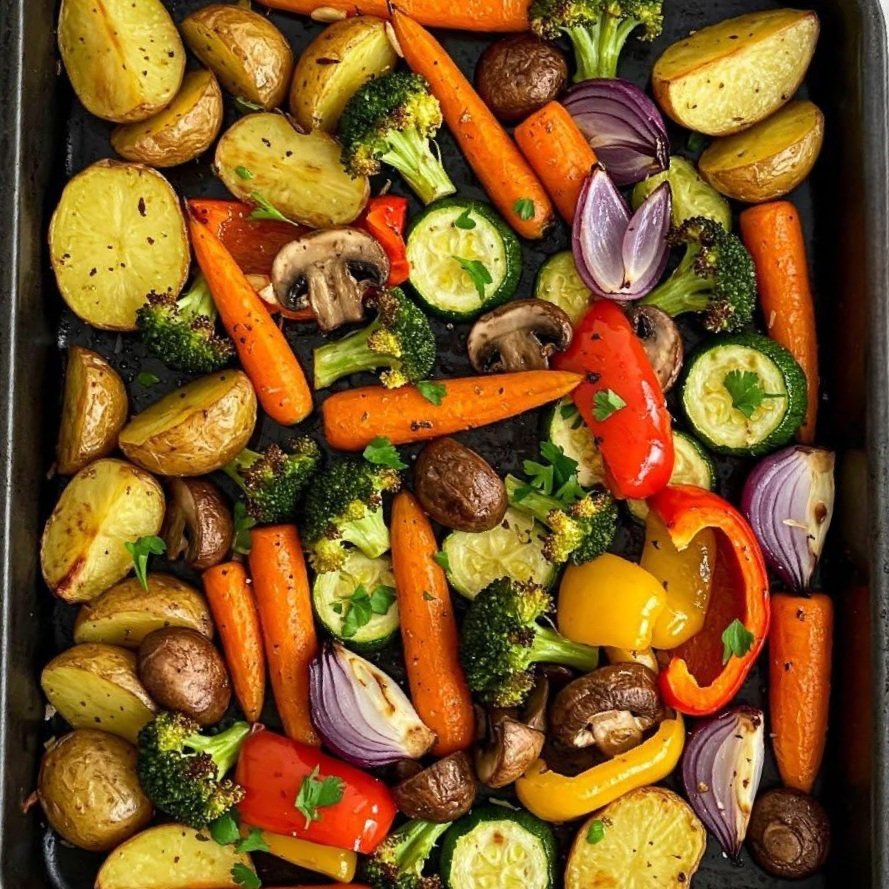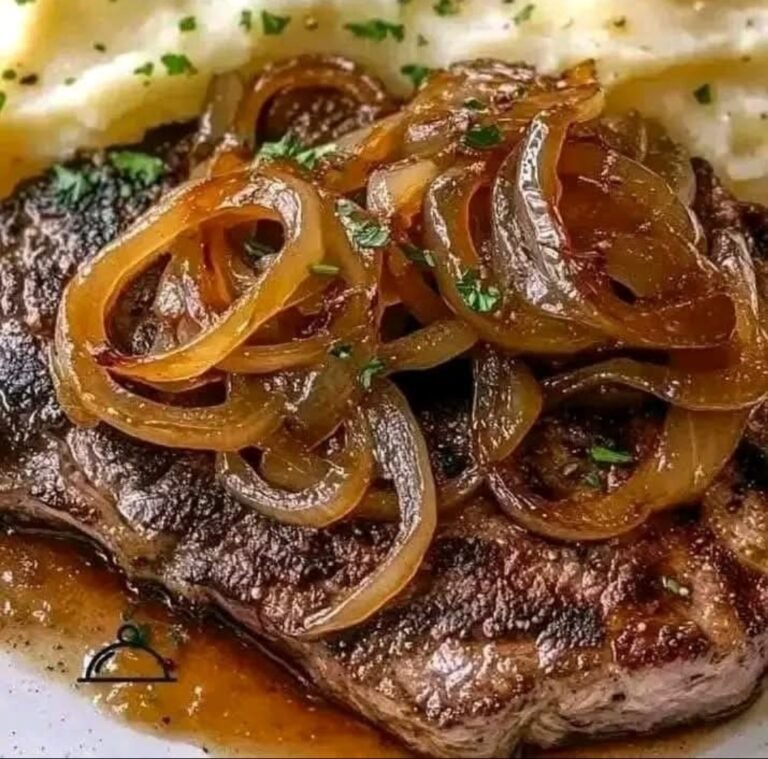Ultimate Oven-Roasted Vegetables: A Colorful, Flavor-Packed Dish

Nothing beats the vibrant colors, caramelized edges, and irresistible aromas of oven-roasted vegetables. This versatile recipe transforms everyday veggies into a mouthwatering masterpiece that’s perfect as a side dish, a vegetarian main course, or a healthy addition to meal prep. Whether you’re a seasoned home cook or a kitchen newbie, this guide will walk you through creating a tray of perfectly roasted vegetables with crispy exteriors and tender, flavorful interiors. With endless and customizable seasonings, you can make this dish your own every time. Let’s dive into this wholesome, crowd-pleasing recipe that’s as nutritious as it is delicious!
Why You’ll Love This Recipe
- Versatile: Use whatever vegetables you have on hand—root veggies, squashes, or even hearty greens.
- Customizable: Switch up the seasonings to match your mood, from smoky paprika to fragrant rosemary or zesty lemon zest.
- Healthy and Wholesome: Packed with vitamins, fiber, and antioxidants, this dish is a guilt-free indulgence.
- Easy Prep: Minimal effort for maximum flavor—just chop, season, and roast!
- Meal Prep Friendly: Make a big batch to enjoy throughout the week in salads, wraps, or grain bowls.
Ingredients
This recipe is all about flexibility, so feel free to mix and match vegetables based on your preferences, what’s in season, or what’s hiding in your fridge. Here’s a suggested list of vegetables and seasonings to get you started:
Vegetables (Choose 6–8 cups total, chopped into bite-sized pieces):
- Root Vegetables: Carrots, sweet potatoes, parsnips, or beets for natural sweetness and hearty texture.
- Squashes: Zucchini, butternut squash, or delicata squash for a tender, melt-in-your-mouth bite.
- Cruciferous Veggies: Broccoli, cauliflower, or Brussels sprouts for nutty, charred flavors.
- Peppers and Onions: Bell peppers (red, yellow, or green) and red onions for vibrant color and subtle sweetness.
- Mushrooms: Cremini, shiitake, or portobello for an earthy, umami kick.
- Eggplant: Adds a creamy texture when roasted.
- Cherry Tomatoes: For bursts of juicy flavor (add these halfway through cooking to avoid overcooking).
Seasoning and Flavorings:
- Olive Oil: 3–4 tablespoons of extra-virgin olive oil to promote browning and crispiness.
- Salt and Pepper: Kosher salt and freshly ground black pepper to enhance natural flavors.
- Herbs: 1–2 teaspoons of dried thyme, rosemary, oregano, or Italian seasoning for aromatic depth.
- Spices: 1 teaspoon of smoked paprika, cumin, garlic powder, or chili powder for a bold twist.
- Garlic: 2–3 cloves, minced, for a savory, roasted garlic flavor (optional).
- Lemon Zest or Juice: 1 tablespoon of fresh lemon juice or zest for a bright, tangy finish (optional).
- Fresh Herbs: Chopped parsley, cilantro, or basil for a fresh garnish (optional).
- Optional Add-Ins: ¼ cup grated Parmesan cheese, nutritional yeast (for a vegan cheesy flavor), or a drizzle of balsamic glaze for extra pizzazz.
Equipment Needed
- Large mixing bowl
- Rimmed baking sheet (or two, to avoid overcrowding)
- Parchment paper or silicone baking mat (for easy cleanup)
- Spatula or tongs for flipping
- Sharp chef’s knife and cutting board
Instructions
Follow these simple steps to create a tray of golden, caramelized vegetables that will steal the show at any meal.
Step 1: Preheat and Prep
- Preheat your oven to 400°F (200°C). This temperature strikes the perfect balance for roasting, ensuring crispy edges without drying out the veggies.
- Line a large baking sheet with parchment paper or a silicone baking mat to prevent sticking and make cleanup a breeze.
Step 2: Prepare the Vegetables
- Wash all vegetables thoroughly under cold water to remove dirt or debris.
- Peel vegetables like carrots, sweet potatoes, or beets if desired (leaving the skin on adds texture and nutrients).
- Chop the vegetables into uniform, bite-sized pieces (about 1-inch chunks) to ensure even cooking. For denser vegetables like potatoes or carrots, aim for slightly smaller pieces than softer veggies like zucchini or bell peppers.
- Pro Tip: If using a mix of hard and soft vegetables, consider parboiling the denser ones (like carrots or potatoes) for 5–7 minutes in boiling water to soften them slightly. Drain and pat dry before seasoning.
Step 3: Season the Vegetables
- In a large mixing bowl, combine the chopped vegetables with 3–4 tablespoons of olive oil. Toss to coat evenly, ensuring every piece is lightly glossy (too much oil can make them soggy).
- Sprinkle with kosher salt, freshly ground black pepper, and your chosen herbs and spices. Add minced garlic if using.
- Toss again to distribute the seasonings evenly. Don’t be shy—well-seasoned veggies are the key to bold flavor!
- Flavor Idea: Try a Mediterranean-inspired blend with oregano, thyme, and a pinch of red pepper flakes, or go smoky with paprika and cumin.
Step 4: Arrange for Roasting
- Spread the seasoned vegetables in a single layer on the prepared baking sheet. Avoid overcrowding, as this can cause the veggies to steam instead of roast. If needed, divide the veggies between two baking sheets.
- Ensure there’s a bit of space between each piece for optimal air circulation and caramelization.
Step 5: Roast to Perfection
- Place the baking sheet in the preheated oven and roast for 25–35 minutes, depending on the vegetables and your oven.
- Halfway through (around 15 minutes), use a spatula or tongs to flip the vegetables. This ensures even browning and prevents sticking.
- The veggies are done when they’re tender when pierced with a fork and have golden-brown, slightly crispy edges. Some veggies, like broccoli or cauliflower, may develop delicious charred spots—embrace them!
Step 6: Add Finishing Touches
- Remove the baking sheet from the oven and let the vegetables cool slightly (1–2 minutes).
- For a burst of freshness, squeeze fresh lemon juice over the veggies or sprinkle with lemon zest.
- Garnish with chopped fresh herbs like parsley or basil for a pop of color and flavor.
- If desired, sprinkle with grated Parmesan, nutritional yeast, or a drizzle of balsamic glaze for an extra layer of decadence.
Step 7: Serve and Enjoy
- Transfer the roasted vegetables to a serving platter or bowl.
- Serve immediately as a side dish alongside grilled chicken, steak, or fish, or enjoy as a vegetarian main course with a side of quinoa, rice, or crusty bread.
- These veggies also shine in salads, grain bowls, wraps, or as a topping for creamy hummus.
Cooking Times for Common Vegetables
To help you plan, here are approximate roasting times at 400°F (200°C) for popular vegetables (based on 1-inch pieces):
- Soft Vegetables (zucchini, bell peppers, mushrooms, cherry tomatoes): 15–20 minutes
- Medium Vegetables (broccoli, cauliflower, eggplant): 20–25 minutes
- Dense Vegetables (carrots, sweet potatoes, beets, parsnips): 30–35 minutes
If mixing vegetable types, check softer veggies early and remove them if done, letting denser ones roast longer.
Tips for Perfect Roasted Vegetables
- Cut Evenly: Uniform pieces ensure consistent cooking. A sharp knife makes prep easier and safer.
- Don’t Skimp on Oil: A light coating of oil promotes browning and prevents drying out, but avoid overdoing it.
- Spread Them Out: Overcrowding leads to steaming, so use two baking sheets if needed.
- Flip for Evenness: Turning the veggies halfway through ensures all sides get that golden, caramelized finish.
- Experiment with Flavors: Try different seasoning blends like za’atar, curry powder, or herbs de Provence for global flair.
- Use High Heat: 400°F is ideal for roasting, but if you want extra crispiness, try 425°F and watch closely to avoid burning.
- Batch Cooking: Double the recipe and roast on two sheets, rotating their positions in the oven halfway through for even cooking.
Storage and Reheating
- Storage: Let the roasted vegetables cool completely, then store in an airtight container in the refrigerator for up to 4–5 days.
- Freezing: Place cooled veggies in a freezer-safe bag or container and freeze for up to 3 months. Thaw in the fridge before reheating.
- Reheating: Warm in a 350°F oven for 10–15 minutes, or microwave in 30-second intervals until heated through. For crispiness, reheat in a skillet with a drizzle of oil.
Serving Suggestions
Oven-roasted vegetables are incredibly versatile. Here are some creative ways to enjoy them:
- As a Side: Pair with roasted chicken, grilled salmon, or a juicy steak for a balanced meal.
- In Grain Bowls: Combine with quinoa, farro, or brown rice, and add a tahini or yogurt dressing.
- In Salads: Toss with arugula, feta, and a lemon vinaigrette for a hearty salad.
- In Wraps or Tacos: Stuff into tortillas with hummus, avocado, or tzatziki for a quick lunch.
- As a Pizza Topping: Scatter over homemade or store-bought pizza dough with mozzarella.
- With Dips: Serve alongside creamy hummus, guacamole, or a spicy harissa dip for a party platter.
Dietary Adaptations
- Vegan: This recipe is naturally vegan without the Parmesan cheese. Use nutritional yeast or skip the cheese entirely.
- Gluten-Free: Completely gluten-free, making it suitable for those with gluten sensitivities.
- Low-Carb/Keto: Stick to low-carb veggies like broccoli, cauliflower, zucchini, and mushrooms, and avoid starchy ones like potatoes.
- Paleo/Whole30: Compliant as long as you use approved oils (like olive or avocado oil) and skip the cheese.
FAQs
Can I use frozen vegetables?
Yes, but fresh is best for texture. If using frozen, thaw and pat dry thoroughly to avoid excess moisture, and expect a slightly softer texture.
How do I prevent soggy vegetables?
Ensure the veggies are dry before seasoning, use enough oil, spread them out on the baking sheet, and roast at a high enough temperature (400°F or higher).
Can I make this ahead?
Absolutely! Chop the veggies a day in advance and store in the fridge. You can also roast them ahead and reheat before serving.
What if my veggies burn?
Lower the oven temperature slightly or reduce cooking time. Check softer veggies early and remove them if done.
Final Thoughts
This oven-roasted vegetables recipe is your ticket to a healthy, flavorful dish that’s as easy as it is delicious. With endless combinations of vegetables and seasonings, you can reinvent this recipe to suit any occasion, from weeknight dinners to holiday feasts. The golden, crispy edges and tender centers will have everyone reaching for seconds, and you’ll love how simple it is to whip up. So grab your favorite veggies, preheat that oven, and get ready to enjoy a rainbow of flavors in every bite!
Have a favorite veggie combo or seasoning blend? Share it in the comments below—we’d love to hear your twist on this classic dish! 🌽🥕🥦





